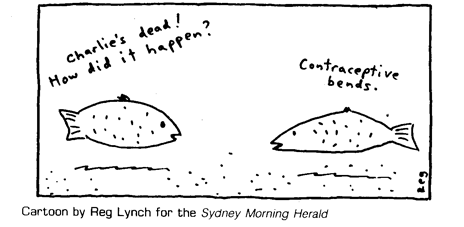
by Sharon Beder
first published by Allen & Unwin, Sydney, 1989
Introduction
Sewers seaward
Toothless watchdog
Toxic fish
Sewer-side surfing
Public relations battle
Events of 1989
Beyond Sydney
Conclusion
Bibliography
Often the level which is considered safe for human consumption purposes is higher than the level considered safe for protection of fish and birds.
In 1987 a United States Office of Technology Assessment Report argued that ‘a strong overall case can be established that waste disposal activities are contributing significantly to substantial declines in the quality of marine waters and harming marine organisms’. The report noted that some organisms are more vulnerable than others, especially bottom-dwelling organisms and those which spend all or part of their lives in coastal waters, as well as those that inhabit polluted waters during sensitive parts of their life cycles. Also marine birds and mammals which are at the top of the food chain can suffer because of the accumulation of pollutants which can lead to impaired reproduction in the animals. For example, in California, the decline of the brown pelican population and that of several other bird species has been directly linked to DDT-contaminated fish.
Actual deaths of organisms due to pollution are difficult to detect, unless there is a mass killing that causes fish to be washed up in numbers on a beach or shore, because very sick or dead organisms don’t last very long. Nevertheless, other symptoms such as behavioural and physiological effects, as well as changes in abundance and distribution of organisms and fish, have been detected in various polluted coastal waters in the United States and the US Office of Technology Assessment report states that:
Noticeable physiological effects include fin erosion (fin rot), ulcers, shell disease or erosion, tumours and skeletal anomalies. Resistance to infection, growth and reproductive ability can also be affected and although these effects may not be immediately fatal they can lead to a premature death. More- over, submerged aquatic vegetation, which is an important part of the ecosystem that not only provides shelter and food but also sediment-stabilising functions, seems to have been generally decreasing in the United States coastal areas and bottom-dwelling communities ‘have been affected by waste disposal in every region of the country’.a growing body of evidence links these effects to exposure to pollutants that sometimes are present at very low concentrations or to environmental changes induced by pollutants . . . The effects are concentrated in estuaries and coastal waters, but detectable effects also have been found in fish far from shore in the open ocean . . . considerable circumstantial evidence indicates that pollutants from waste disposal activities have contributed to declines of major fish populations in the United States.
